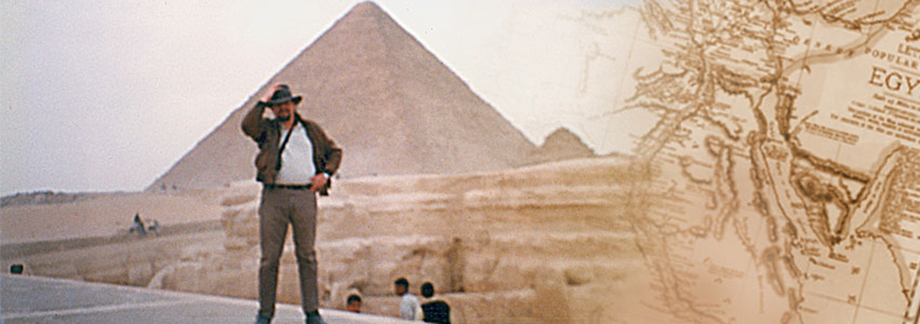Taking a poll here.
The fact that we have pyramids or pyramid like structures around the world among different cultures that never were connected with each other proves that:
A. ALIENS!
B. ATLANTIS!
C. If you want to build something really big out of bricks or blocks, the easiest thing to do is just make a big pile.
My answer today is C.
I was a firm believer and did much research into both A and B (and of the variant A1. ALIENS! FROM ATLANTIS!).
But it was the 70s. If you think paranormal is big now, you should have been around for the Golden Age.
I’m talking Pyramid Power.
I haven’t heard the term used in a while, but back in the 70s and early 80s it was the cat’s pajamas (also a term I haven’t heard in a while).
When Uri Geller was on Merv Griffin bending spoons with his mind, the rest of us were sharpening razor blades, treating migraines, and curing erectile disfunction with the awesome power inherent in that magical shape.
You could buy cardboard Pyramid Power kits from the backs of magazines, or go for the super deluxe model that you sat inside in your living room. Pyramid Power was the panacea. It cured what ailed us. It kept us young and vital and was fueling the Sexual Revolution, or at least the one-night stand.
The origins of this mania started as a concept about keeping meat fresh.Iin the 1930s a French dowser named Antoine Bovis theorized that the pyramid shape would inherently “mummify” organic materials. The basis of his thinking is a bit fuzzy, I am not up on the idea of dowsing enough to work out quite how he deduced pyramid shapes had this power. He extrapolates in his theory that since his cardboard shape worked with a small fish and a piece of meat, the bigger Egyptian pyramid must contain the same magnetic energies.
There is an apocryphal account that he observed mummified cats that had supposedly been created by the Egyptian pyramid itself. Of course, the interior of the pyramid is relatively warm and dry and works fairly good as a giant dehydrator. But we know that couldn’t be what was doing it. Had to be some mystic force.
After the Second World War, an enterprising Czech inventor took Bovis’s ideas of concentrated magnetism and started marketing his own line of patented cardboard pyramid “sharpeners” to prolong the life of razor blades during the bleak Soviet bloc economy. They were apparently successful enough to draw the attention of a couple of authors who included these ideas in the book Psychic Discoveries Behind The Iron Curtain in 1970.
In an American generation that was deeply embracing counterculture, ideas of supernatural and paranormal were frequently the topic of general conversation. People were experimenting with altered states of consciousness, Hinduism, Buddhism, Taoism, and other non-abrahamic religions, including Wicca and other occult practices. “Secret” practices that had been suppressed by the Soviets (and probably the CIA) just had to be looked into. Von Däniken had just had tremendous public success with Chariots of the Gods, and the idea of an ancient alien spiritual techno-medicine just hit the right chord.
Generally if there’s not a satisfying rational explanation for something, people are willing to accept a much more enticing irrational one. Thus the pyramid business took off, initially with dueling books both entitled Pyramid Power. As you might imagine, theories that the pyramid shape might augment or reflect or collect earth’s natural magnetic field in such a way as to deter degeneration, got intertwined with any wild occult paranormal pseudoscientific idea that caught public attention.
And we all did our pyramid things. I think I built one or two. I watched every show that mentioned it. I read all the books I could find (and without the ‘Zon, they were few). And like Agent Mulder I wanted to believe. There had to be a secret power. There must have been some kind of ancient civilization. Aliens had to have helped them cut the stones.

Although many designers choose to show the wands more literally as torches, Smith has elected to portray them as simple branches, with a few leaves here and there. This is also symbolic, as it refers to the Rod of Aharon. Moses half-brother wields his staff significantly during the 10 plagues, and later in Exodus, it is said to have budded, showing the power of the Almighty to bring life from the dry wood. It is one of the relics kept in the Ark of the Covenant, and in the RWS Tarot symbolizes the present of hidden fire within.
And then I went there. I went to the pyramid. I climbed the passage and scrambled across the rock into the King’s Chamber and I stood in the heart of the Great Pyramid of Giza and expected my Great Epiphany. And possibly also alien teleportation and super powers.
And then I realized, sliding my hands across those glassy smooth stone walls with the perfectly fitted seams, how it had been done.
Lots and lots of people, with lots and lots of sand, and lots and lots of time.
No aliens. No laser beams. No antigravs.
Just people, sand, and time.
But the Great Epiphany was something even better.
Now, mind you, I do understand why everyone wants to believe. Aside from it just being a lot cooler to think it was space aliens with laser guns posing as ancient gods, the Pyramid itself evokes a sense of massive awe that is hardly paralleled. I have only experienced the same kind of mental and spiritual transport a few other times. Once was the Chartres Cathedral in France, and once was the Saturn V rocket here in Houston.
Now all of these things are firstly very very big. They’re bigger than many things we encounter in our lives. The Pyramid was the tallest building on Earth until the Eiffel Tower was built. But the Eiffel Tower, though admittedly cool, and really big, doesn’t impose itself upon you like the Pyramid does.
There’s the old saying that all men fear time, but time fears the pyramids. That’s a palpable feeling when you are standing near it.
My first experience of Chartres was much like my first experience of the Pyramid. You are driving along and then suddenly there is this massive thing rising out of the horizon. Chartres is situated on a natural hill, and at the time (late 1990s) was surrounded by large wheat fields, so it’s massivity was augmented by this isolation. Of course, it sits in the middle of the modern city, but it’s hugeness is still unique for the locale. So both with Chartres and the Pyramid you can approach them and get the same sense of how they appeared at the time of their builders. They are effectively timeless.

The Three of Pentacles shows the fine detail work inherent in the Gothic style. The pointed arches are all parts of full circles, that push into each other. The geometry defining them could be done with a simple divider (what we sometimes call a compass in math class). The trefoils – here holding the pentacles, and quatrefoils were circles arranged on circles, and the great rose windows that pierce the walls of the apse and transept are circles holding up circles holding up circles, all of them pushing together in a magic dance that allowed such massive structures to be made with thin walls and glass windows.
Chartres photo from Wikipedia by Olvr – Own work, CC BY-SA 3.0, https://commons.wikimedia.org/w/index.php?curid=16331210
We know more or less how Chartres was constructed. It took hundreds of years, and lots of people, and lots of stone and other resources. It uses sophisticated and ingenious technologies to lift massive weights high above the ground, and keep them there, without benefit of an internal steel skeleton. Chartres, like all Gothic Cathedrals, is held up by gravity. This oxymoronic statement may seem absurd at first, but the basic engineering principle goes back to the Romans.
The Romans worked out the true arch. The arch is half of a circle. Gravity is causing every stone in the circle to fall toward the center, but every stone in the circle is caught between two other stones also trying to fall so that the whole thing stays up.
If you put a row of arches in line after each other you get a vault. If you put two of them in perpendicular, you get what is called a groin vault, which gives you a square room underneath with openings on all four sides. Large Roman buildings employed these techniques to create very large interior spaces. They also used the same principle to create the dome, where instead of going in a single direction the arches pivot around a central point. And because the stones near the top were pushing into each other all around the circle, they could even leave an opening – called an oculus or “eye”- in the middle of the dome and it would still stay up.
The only difficulty in such structures was that the weight of the downward pushing stones tends to press outward at the bottom, so initially Roman buildings had to have walls with equal or great mass than the weight of the stones in the arches.
The Gothic innovation, was in utilizing arches upon arches upon arches, to make thinner lighter walls, which they filled with brilliant stained glass, and flying buttresses, which pressed inward against the vaults but carried the weight out and down to a set of descending piers. The whole effect results in a kind of wedding cake extravaganza of a building.
The Pyramid, by contrast, comes from a time where post and lintel construction is necessary. If you are using stone, you can only make your openings as wide as the stone you are using for the lintel – the piece that goes across the top – will bear before it breaks. Or you have to use a bigger stone. Which means you have to have bigger posts. And a lot of them. This is why the Hypostyle Hall in the Temple of Amen Ra at Karnak has the forest of massive pillars. Think Stonehenge, but one a bigger scale.
Even with that though, the chambers inside the Great Pyramid can’t bear the weight of the structure above it without some pretty amazing tricks. The passage that goes up into the pyramid is only a few feet wide, so it is constructed of limestone and using basic post and lintel method. But the burial chambers would need to be much bigger, and for whatever reason, Cheops wanted them inside the stone mass of the Pyramid. This is generally believed to have been to deter robbers, but Peter Tomkins, in his Secrets of the Great Pyramid Revealed offers some other plausible ideas -ideas that are as nifty as space aliens and still don’t involve Atlantis.
In any case, the middle parts of the Pyramid use heavy granite, a stone much stronger and capable of spanning a chamber 20 or 30 feet wide without snapping. Of course, it’s incredibly heavy, is almost impossible to carve with copper chisels (even if you were sharpening them in a pyramid) and was quarried hundreds of miles up the Nile at Aswan.
And yet there it was smooth as glass, with the faintest hint of a joint between the massive blocks. And above me the great weight of about another third of the Pyramid over my head was pressing down on those granite roof beams. As they had been for thousands of years.
So clearly, Pharoah’s overseer of works just phoned over to where they were building Stonehenge and got Merlin to come move them. No aliens at all.
Thing is, we know now that they rough cut the granite stone using fire cracking. They moved the great slabs from the quarry using various ramps, sledges, mud “lubricant” and a whole lot of people pulling on ropes. They barged them down the Nile to the job site, where the docks were a lot closer than they are today, and using more ramps, sledges, and people drug them up to where they belonged.
And then some dude sat there with sand, and a jug of water, and maybe a reed or papyrus matte, and sanded them glassy smooth. Okay, fine. It was several dudes. But it’s the same thing they did at Chartres 3000 years later and nobody claims that was aliens or mermaids or the Loch Ness Monster.
And in both cases, they were building a monument to God.
It’s just, that in the case of the Pyramid, God came to look over the building site from time to time.
Even though in the last couple of decades all that I have just explained has become widely known, we still have a fascination with this curious shape. I personally have several pyramids made from semiprecious stones and crystals. And for all of them I probably also have an obelisk, a sphere, and probably a skull carved from the same rocks.
And I am not alone, judging from the numbers of rock and crystal pyramids that I find wherever fine rocks and crystals are sold. Clearly we still believe in Pyramid Power, if not exactly in how it was perceived in the 1970s. The physical shape of the pyramid is a touchstone to our psyche in a way that few things are. Even when we see simple the two dimensional outline of it as a triangle, our minds evoke exotic locales, ancient civilizations, and mysteries. The pyramid is sacred geometry. And was meant to be.
The Great Pyramid in Egypt and all it’s little brothers and sisters up and down the Nile were meant to be magic engines that transported the soul of the Pharaoh (and later lesser personages) to the sky where they would ride in the Boat of Ra for all eternity. The shape was derived from both the “god rays” we sometimes experience when the sun shines down through clouds, and also from a stone emblematic of the Primordial Mound of Earth that formed in the beginning of time, and from which grew the Lotus that Ra emerges from.
In the Mesopotamian cultures great ziggurats were built that were capped with temples, bringing the priesthood and the kings closer to the gods that lived in the sky. In Mesoamerica, pyramid structures fulfilled a similar purpose, though we have some that were also used as tombs. It’s probable that burying the dead king in the pyramid temple was seen to give an additional power and sacredness to it, but as far as we know Mesoamerican pyramids were not conceived as tombs.
There is a parallel here to the numerous famous personages who are buried in modern cathedrals. The church is holy ground. The holier the church, the more important the community of it’s dead become. Tompkins puts forth that assuming the only purpose of the Egyptian pyramid was a tomb, would be the same as asserting that the only purpose of Westminster Abbey was to bury the royals of Britain. While it is done there, there are a number of other purposes.
The orientation of various pyramids to astronomical phenomenon cannot be denied. We tend today to separate sacred and scientific, but this has never been the case until recently. Building anything required consultation of the spirits, the stars, and the omens, and building something as important as a pyramid or temple complex even moreso. It’s telling that in China some pyramid like structures were created for the purpose of improving the flow of chi in accordance with Feng Shui principles. They were human made mountains because natural mountains were not in the proper place.
Much has been made of secret numbers and ratios and measurements inherent in the Pyramid. And they are. This is because they were intended to be there, just as they were intended to be in Chartres and it’s sister cathedrals. We “discover” the correspondences to our modern measurements because our modern metrics (not the metric system, but the old ones – foot, yard, fathom, etc.) are derived from scales used to create the Pyramid.
All these things only seem wild and crazy and beyond belief if we assume that our ancestors were all a bunch of idiots, walking around with knuckles dragging.
The splendor of Pax Romana brought along with it the propaganda that the Roman way was the best way. A certain amount of this arrogance was inherited from the Hellenic Greeks who wrote up standards of truth and beauty and morality and ethics and just about everything. When the broken bones of these civilizations were resurrected in the Renaissance, they were idealized by the secular humanists over the cultish, insular, and dogmatic church of the Middle Ages.
So the secrets handed down from master to apprentice mason were divorced from their sacred meanings, and ultimately became purely mechanical operations. In this transition, the idea that pre-Alexandrian cultures could have possessed any such understanding was scoffed at. And so we reached the 1970s comfortably assured that the pyramids had to be built by aliens because human brains just couldn’t do that.

If we underestimate the human capacity to imagine, to dream, and to dare, we do a great disservice to ourselves and our ancestors. The pyramid builders may not have understood mathematics and engineering as we do, but they had a technology and it worked. Despite the stories told by Greeks centuries afterward, the majority of the work on the monuments of Egypt were done by free people, in exchange for food and other needs, during the time of the Nile flood. Like the workers on the grand Gothic monuments, they were assured that their efforts would guarantee them a life everlasting.
In 1903, the first heavier that air machine took off at Kitty Hawk, North Carolina, and flew a third of the length of the Saturn V rocket. Sixty-five years later human beings landed on the surface of the moon. We generally have been brought up believing that this accelerated leap in technology is a purely modern thing.
The Step Pyramid of Djoser was devised and executed by the vizier and sage Im-Ho-Tep around 2600 BCE. The Great Pyramid of Cheops was completed about 100 years later, and assuming the current figure of 20 years to build, that’s only a little longer than it took us to get from Kitty Hawk to the moon.
We did not have any help from the aliens. We didn’t even have electronic computers until the very end of the process, and we were checking those with mechanical sextants and slide rules because these 18th and 19th century devices were more accurate than the roomfuls of tubes and wires.
I would like to think, that should humanity survive it’s comparative infancy and follow those first explorers out into the void, that our progeny will someday look back at that weird collection of cylinders in the museum down at Clear Lake, with the same kind of awe and admiration and wonder that we feel about that old pyramid.
Until next time, remember that humans with their mind and their will can build mountains. Aliens not required.

